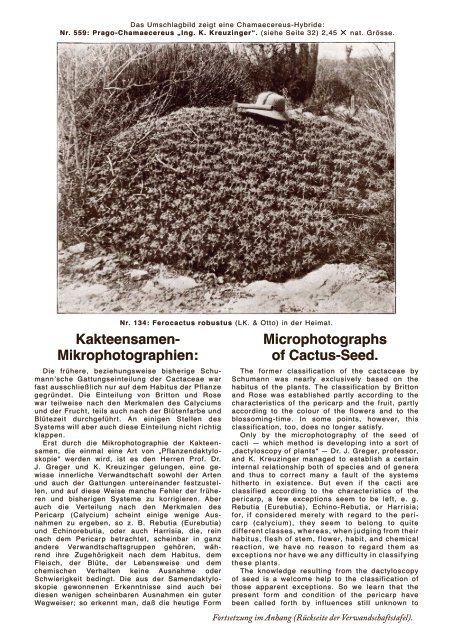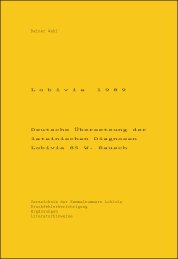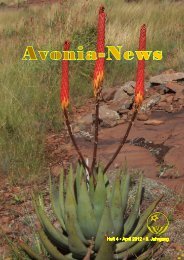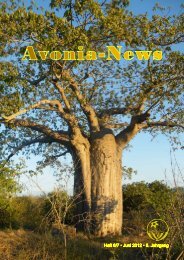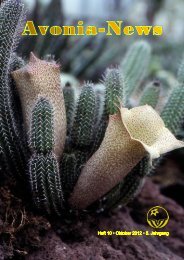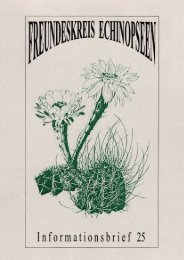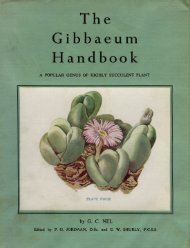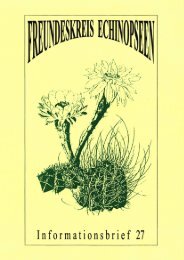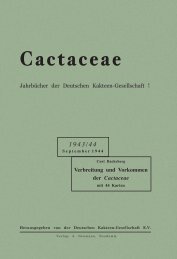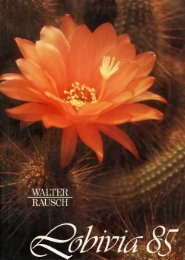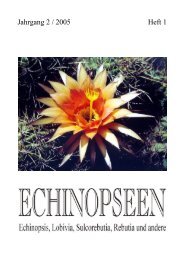Erfolgreiche ePaper selbst erstellen
Machen Sie aus Ihren PDF Publikationen ein blätterbares Flipbook mit unserer einzigartigen Google optimierten e-Paper Software.
Das Umschlagbild zeigt eine Chamaecereus‐Hybride:<br />
Nr. 559: Prago‐Chamaecereus „Ing. K. Kreuzinger“. (s<strong>ie</strong>he Seite 32) 2,45 × nat. Grösse.<br />
Nr. 134: Ferocactus robustus (LK. & Otto) in der Heimat.<br />
Kakteensamen‐<br />
Mikrophotograph<strong>ie</strong>n:<br />
D<strong>ie</strong> frühere, bez<strong>ie</strong>hungsweise bisherige Schumann’sche<br />
Gattungseinteilung der Cactaceae war<br />
fast ausschl<strong>ie</strong>ßl<strong>ic</strong>h nur auf dem Habitus der Pflanze<br />
gegründet. D<strong>ie</strong> Einteilung von Britton und Rose<br />
war teilweise nach den Merkmalen des Calyciums<br />
und der Frucht, teils auch nach der Blütenfarbe und<br />
Blütezeit durchgeführt. An einigen Stellen des<br />
Systems will aber auch d<strong>ie</strong>se Einteilung n<strong>ic</strong>ht r<strong>ic</strong>htig<br />
klappen.<br />
Erst durch d<strong>ie</strong> Mikrophotograph<strong>ie</strong> der Kakteensamen,<br />
d<strong>ie</strong> einmal eine Art von „Pflanzendaktyloskop<strong>ie</strong>“<br />
werden wird, ist es den Herren Prof. Dr.<br />
J. Greger und K. Kreuzinger gelungen, eine gewisse<br />
innerl<strong>ic</strong>he Verwandtschaft sowohl der Arten<br />
und auch der Gattungen untereinander festzustellen,<br />
und auf d<strong>ie</strong>se Weise manche Fehler der früheren<br />
und bisherigen Systeme zu korrig<strong>ie</strong>ren. Aber<br />
auch d<strong>ie</strong> Verteilung nach den Merkmalen des<br />
Per<strong>ic</strong>arp (Calycium) scheint einige wenige Ausnahmen<br />
zu ergeben, so z. B. Rebutia (Eurebutia)<br />
und Echinorebutia, oder auch Harrisia, d<strong>ie</strong>, rein<br />
nach dem Per<strong>ic</strong>arp betrachtet, scheinbar in ganz<br />
andere Verwandtschaftsgruppen gehören, während<br />
ihre Zugehörigkeit nach dem Habitus, dem<br />
Fleisch, der Blüte, der Lebensweise und dem<br />
chemischen Verhalten keine Ausnahme oder<br />
Schw<strong>ie</strong>rigkeit bedingt. D<strong>ie</strong> aus der Samendaktyloskop<strong>ie</strong><br />
gewonnenen Erkenntnisse sind auch bei<br />
d<strong>ie</strong>sen wenigen scheinbaren Ausnahmen ein guter<br />
Wegweiser; so erkennt man, daß d<strong>ie</strong> heutige Form<br />
M<strong>ic</strong>rophotographs<br />
of Cactus‐Seed.<br />
The former classif<strong>ic</strong>ation of the cactaceae by<br />
Schumann was nearly exclusively based on the<br />
habitus of the plants. The classif<strong>ic</strong>ation by Britton<br />
and Rose was established partly according to the<br />
characterist<strong>ic</strong>s of the per<strong>ic</strong>arp and the fruit, partly<br />
according to the colour of the flowers and to the<br />
blossoming‐time. In some points, however, this<br />
classif<strong>ic</strong>ation, too, does no longer satisfy.<br />
Only by the m<strong>ic</strong>rophotography of the seed of<br />
cacti — wh<strong>ic</strong>h method is developing into a sort of<br />
„dactyloscopy of plants“ — Dr. J. Greger, professor,<br />
and K. Kreuzinger managed to establish a certain<br />
internal relationship both of spec<strong>ie</strong>s and of genera<br />
and thus to correct many a fault of the systems<br />
hitherto in existence. But even if the cacti are<br />
classif<strong>ie</strong>d according to the characterist<strong>ic</strong>s of the<br />
per<strong>ic</strong>arp, a few exceptions seem to be left, e. g.<br />
Rebutia (Eurebutia), Echino‐Rebutia, or Harrisia;<br />
for, if considered merely with regard to the per<strong>ic</strong>arp<br />
(calycium), they seem to belong to quite<br />
different classes, whereas, when judging from their<br />
habitus, flesh of stem, flower, habit, and chem<strong>ic</strong>al<br />
reaction, we have no reason to regard them as<br />
exceptions nor have we any diff<strong>ic</strong>ulty in classifying<br />
these plants.<br />
The knowledge resulting from the dactyloscopy<br />
of seed is a welcome help to the classif<strong>ic</strong>ation of<br />
those apparent exceptions. So we learn that the<br />
present form and condition of the per<strong>ic</strong>arp have<br />
been called forth by influences still unknown to<br />
Fortsetzung im Anhang (Rückseite der Verwandschaftstafel).


